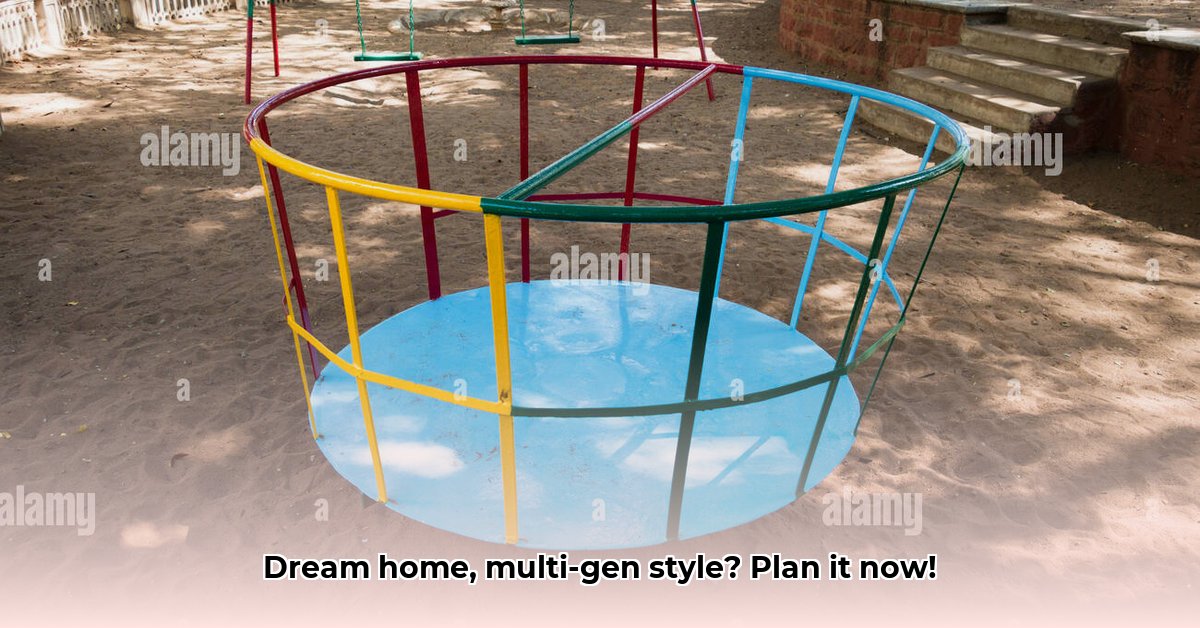Want a home where everyone’s happy, from Grandma and Grandpa to the grandkids? Building or adapting a home for multiple generations is becoming more and more popular, and it can be a fantastic way for families to stay close and support each other, offering shared experiences and combined resources. But it’s also a big project, so let’s make sure you do it right with some master multi-generational house planning. This comprehensive guide will walk you through everything you need to know – from identifying family needs to navigating construction and renovations. We’ll explore how to strike the perfect balance between shared spaces and private retreats, ensure accessibility for all, manage your budget effectively, and build a home where lasting family memories are made! For high-end design inspiration, check out this resource.
Multi-Generational House Planning: Designing Your Dream Family Home
Learn about thoughtful design principles and family needs assessment to create a comfortable and harmonious home for everyone.
Building a home where multiple generations thrive together is a significant undertaking, but it is an incredibly rewarding endeavor. It’s far more than simply adding extra bedrooms; it’s about meticulously crafting a living space that caters to the unique needs of each family member while simultaneously fostering a sense of togetherness and respecting individual privacy. This demands thorough planning, a deep understanding of each family member’s needs, and a commitment to accessibility and safety. Let’s delve into the process of successfully planning your multi-generational home, focusing on space optimization, supportive technologies, and the creation of a truly inclusive environment for all age groups.
Understanding Your Family’s Needs: The Foundation of Your Plan
Before you even begin sketching floor plans, it’s essential to develop a crystal-clear understanding of your family’s current and future needs and expectations. Who will be living under the same roof? What are their individual wants, needs, and non-negotiables – both now and in the years to come? Consider everyone’s physical needs (such as accessibility for grandparents with mobility challenges), emotional needs (sufficient personal space and opportunities for shared family time), and lifestyle preferences (e.g., quiet study areas versus vibrant entertainment spaces). It’s crucial to balance togetherness with the need for individual retreats, fostering a harmonious and respectful living environment.
Think ahead! How will these needs evolve over the years? Families change, and anticipating these shifts is crucial to ensuring that the home remains functional, comfortable, and relevant for all its occupants.
Here’s a step-by-step approach to understanding your family’s diverse needs:
- The Big Family Chat: Gather everyone – parents, grandparents, adult children, and even older grandchildren – for an open, honest, and respectful discussion about everyone’s needs, desires, and concerns. This conversation should extend beyond basic requirements to encompass lifestyle preferences, privacy expectations, and any potential areas of conflict. It might seem a little daunting, but upfront communication is key to success and sets the stage for a collaborative and inclusive design process.
- Needs Inventory: Create a comprehensive list for each family member, detailing their specific requirements, preferences, and expectations for the new home. Does anyone require a private bedroom suite, a home office, a flexible space for hobbies, or a dedicated area for their pets? Document accessibility needs (such as wider doorways, ramps, or specialized bathroom fixtures). Identify shared space preferences, such as a specific type of kitchen setup, a large family room, or an outdoor entertainment area.
- Long-Term Visioning: Look ahead five, ten, or even twenty years and consider how your family’s needs are likely to change. Will there be new additions to the family (children, spouses, or other relatives)? Will health needs necessitate adjustments to the home? How can the design incorporate flexibility and adaptability to accommodate evolving circumstances? This forward-thinking approach is vital for creating a multi-generational home that truly lasts and provides a comfortable and supportive environment for all its residents throughout their lives.
Key Design Considerations: Bringing Your Vision to Life
Now for the exciting part – the actual design! Here’s what to prioritize:
- Smart Space Planning: The Art of Balance: Effective space planning is the cornerstone of a successful multi-generational home. How can you effectively balance private spaces with communal areas to create a harmonious living environment? Think carefully about the layout of the kitchen, living room, and outdoor spaces. Would separate wings or apartments for different generations be beneficial? Or would a central hub where everyone can gather easily be more appropriate? Perhaps a dedicated play area for children and a quiet lounge for adults? Consider the pros and cons of a single-story versus a multi-story home – it greatly affects the flow, accessibility, and energy efficiency. Consider incorporating flexible spaces that can be adapted to different uses over time, such as a bonus room that can serve as a playroom, a home office, or a guest bedroom.
- Accessibility: Planning for the Future: Designing for aging and mobility limitations should never be an afterthought; it’s a fundamental consideration that must be integrated into every aspect of the design process. Wider doorways, ramps, grab bars, zero-step entries, and elevators are not just nice touches; they’re essential for safe, comfortable, and inclusive living, particularly as family members age. Aim for adaptable bathroom designs, such as roll-in showers, adjustable-height sinks, and comfort-height toilets, and easily accessible kitchen layouts, such as lower counters, pull-out shelves, and front-mounted controls. Consider incorporating smart home technology to further enhance accessibility, such as voice-activated lighting, automated door openers, and remote-controlled window shades.
- Technology: Enhancing Comfort and Safety: Smart home technology can significantly improve convenience, comfort, security, and safety for all residents, regardless of age or ability. Explore integrating features that enhance accessibility (such as automated lighting, voice-activated controls, and smart appliances), improve security (such as smart locks, security cameras, and remote monitoring systems), and boost energy efficiency (smart thermostats, smart lighting systems, and energy-efficient appliances). These technologies not only add convenience but also contribute to peace of mind, a higher quality of life, and reduced energy consumption for all residents.
- Budgeting and Financing: A Realistic Approach: Building a multi-generational home is a significant investment, necessitating prudent financial strategies and careful planning to ensure long-term sustainability. Develop a detailed budget that accounts for every aspect of the project, from architectural design and construction to landscaping and interior finishes, to avoid unpleasant surprises along the way. Research various financing options: mortgages specifically designed for multi-generational homes, construction loans, personal loans, and any potential tax incentives or grants that may be available for multi-family or family-oriented housing projects. Getting pre-approved for a mortgage before you start can provide a clear understanding of your financial capabilities and help you stay on track throughout the project.
Assembling Your Dream Team: Professional Expertise
Don’t try to navigate this complex project alone! Seek professional help from architects, builders, interior designers, and other specialists who have extensive experience with multi-generational homes. Their expertise is invaluable in streamlining the entire build or renovation process, ensuring that the project is completed on time, within budget, and to the highest standards of quality. A specialist will have valuable insights into layout optimization, accessibility considerations, energy-efficient design, and potential challenges you may not have considered. They can also guide you through the complexities of building codes, zoning regulations, and permit requirements, minimizing the risk of costly delays or legal issues. Statistically, homes designed with professional architectural guidance often see a 15-20% increase in long-term value and a greater level of satisfaction among residents.
Case Studies and Inspiration: Learning from Others
Look to real-world examples, case studies, and success stories for inspiration and guidance. Browse architectural websites, home design magazines, and even neighborhood tours to gather images and ideas that resonate with your family’s style, needs, and preferences. Visit open houses of multi-generational homes to experience firsthand the layout, features, and overall ambiance. Seeing how others have tackled similar projects is invaluable in guiding your own planning and design choices and can help you avoid common pitfalls.
Addressing Potential Challenges: Proactive Planning
While multi-generational homes offer numerous benefits, proactively planning for potential challenges is crucial for creating a harmonious and sustainable living environment. Openly discussing potential areas of conflict, such as differing lifestyles, privacy expectations, noise levels, or personal preferences, is essential. Establish clear household expectations, communication strategies, and conflict-resolution mechanisms early in the process. Consider carefully how you’ll handle shared expenses, common areas, household chores, and caregiving responsibilities. A thoughtful and proactive approach to these issues can help prevent friction, promote cooperation, and ensure that everyone feels respected, valued, and supported. Why not implement a rotating chore chart to encourage balanced contributions or establish a regular family meeting to discuss any issues or concerns that arise?
Weighing the Pros and Cons: A Balanced Perspective
| Feature | Pros | Cons |
|---|---|---|
| Shared Living Space | Stronger family bonds, cost savings through shared expenses, shared responsibilities, increased emotional and practical support, enhanced sense of community, opportunities for intergenerational learning and mentorship, reduced social isolation for elderly family members. | Potential for conflict, reduced privacy, adjustments to individual routines and lifestyle preferences, increased noise levels, potential for disagreements over finances and household management, need for clear communication and compromise. |
- Ceramic Tile Backsplash Ideas for Your Kitchen Remodel - December 21, 2025
- Contemporary Kitchen Backsplash Ideas for a Stylish Home - December 20, 2025
- Modern Kitchen Backsplash Ideas To Inspire Your Refresh - December 19, 2025










